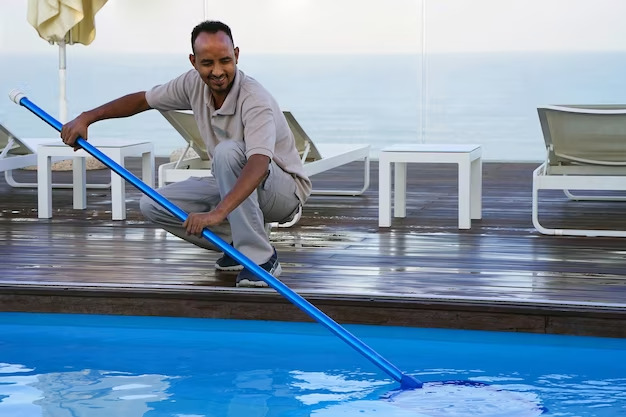
Cleaning your pool at home by yourself requires specific tools and equipment to ensure effective maintenance. According to swimmingpool.com, when it comes to pool care, keep in mind the three C’s of pool care: Circulation, Cleaning, and Chemistry.
Circulation
- Run pool pump 8-12 hours per day
- Backwash or clean filter if pressure is above 10-15 psi
- Clean the skimmer & pump basket
- Keep jets facing circular and downward
Cleaning
- Brush walls, steps, ladders, low circulation spots daily
- Skim the surface daily
- Vacuum once a week or use automatic cleaner
Chemistry
- Test water 1-2 times per week
- Balance pH and alkalinity
- Maintain sanitizer levels
- Shock bi-weekly
Here’s a step-by-step guide along with the necessary tools and equipment.
1. Tools and Equipment
- Pool skimmer or net
- Pool brush
- Telescopic pole
- Pool vacuum or automatic pool cleaner
- Pool test kit or test strips
- Pool chemicals (chlorine, pH adjusters, algaecide, etc.)
- Pool filter cleaning equipment (if needed)
2. Skim the surface
Use a pool skimmer or net attached to the telescopic pole to remove leaves, debris, insects, and any floating objects from the water’s surface.
3. Brush the walls and floor
Attach a pool brush to the telescopic pole and thoroughly brush the walls, floor, steps, and any other surfaces of the pool. This helps remove dirt, algae, and other build-up
4. Vacuum the pool
- If you have a manual pool vacuum, connect it to the telescopic pole and vacuum the pool’s floor, walls, and steps. Move the vacuum slowly and methodically to cover the entire pool surface.
- Alternatively, if you have an automatic pool cleaner, follow the manufacturer’s instructions to set it up and let it clean the pool for you.
5. Clean the pool filter
- Depending on your pool’s filtration system, you may need to clean or backwash the filter regularly to maintain its efficiency.
- If you have a sand filter, backwash it according to the manufacturer’s instructions. If you have a cartridge filter, remove the cartridges and clean them with a hose or specialized cartridge cleaner. If you have a DE (diatomaceous earth) filter, follow the manufacturer’s instructions for proper maintenance and cleaning.
6. Test and balance the water chemistry
- Use a pool test kit or test strips to measure the chemical levels of your pool water, including pH (pH range of 7.2 to 7.8), calcium hardness (200 – 250ppm for concrete pools & 175 – 225ppm for vinyl pools), chlorine (1-3 ppm), alkalinity (range of 80-120 ppm), and other parameters.
- Adjust the chemical levels as necessary. Add chlorine to maintain proper disinfection, pH adjusters to balance acidity/alkalinity, and algaecide to prevent algae growth.
- Follow the recommended guidelines and dosage instructions for your specific pool and chemical products.
Comparison Charts of Pool sanitizer
Chlorine
UNIQUE FEATURES:
- Keeps water clean
- Destroys harmful bacteria
- Keeps water safe for swimming
- Keeps algae away
Chlorine comes in many different forms (tablets, granular, liquid). You should always consult with your pool professional for guidance as to which is best for your pool.
TIPS FOR USING:
Add chlorine granules directly into your pool water or place chlorine tablets to a floating dispenser, skimmer basket, or automatic chlorinator. Never mix chlorinated products together and always follow label directions.
Bromine
UNIQUE FEATURES:
- Breaks apart harmful bacteria
- Remains active longer than chlorine
- Works better in hot water
- More expensive than chlorine
Bromine is a heat-resistant sanitizing element that sanitizes contaminants in pool water.
TIPS FOR USING:
When bromine breaks down, it produces bromamines, which impact its sanitizing function. Shock your pool to rid it of bromamines. If you use bromine tablets, they contain some chlorine for optimal sanitizing function.
Salt Chlorine Generator
UNIQUE FEATURES:
- Produces a purer form of chlorine
- Gentle on eyes and skin
- Lowers pool chemical costs
These salt systems pass electricity through dissolved salt to produce chlorine for a pool.
TIPS FOR USING:
Expect to replace the salt cell after four or more years of use.
NOTE:
| TEST | RANGE |
| pH | 7.2 – 7.6 |
| Total Alkalinity | 120 – 150ppm |
| Calcium Hardness | 200 – 250ppm (Concrete Pools) |
| 175 – 225ppm (Vinyl Pools) | |
| Free Chlorine | 1 – 3ppm |
| Free Bromine | 3 – 5ppm |
| Metals: Copper | 0ppm |
| Metals: Iron | 0ppm |
7. Maintain a regular cleaning schedule
- Establish a routine cleaning schedule for your pool, typically once a week, to keep it clean and well-maintained.
- Skim the surface, brush the walls and floor, vacuum as needed, and test and balance the water chemistry regularly.
8. Monitor and address any issues promptly
Regularly inspect your pool for any signs of problems such as algae growth, cloudy water, or equipment issues. Address these issues promptly to prevent further damage or water quality issues.
Remember to wear appropriate protective gear, such as gloves and goggles, when handling pool chemicals. Follow all safety guidelines and instructions provided with the tools, equipment, and chemicals. If you are unsure about any aspect of pool maintenance, it’s recommended to consult a professional pool service or pool maintenance expert for assistance or you can contact us, we will help you.

Comments